Springs in the air at Wisley
Springs in the air at Wisley
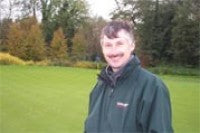 By David Whitaker
By David Whitaker
Back in November we closed nine holes of the course to re-turf all the greens and do other redevelopment work to improve those nine holes with an anticipated opening date in mid April.
The winter has been very kind to us in terms of weather conditions with the temperatures being much higher than normal. The greens have responded very well and we have already been able to hollow core and top-dress them to finalise our levels. We our currently cutting these greens at 5mm. It shows how mild the weather has been as we are having to syringe the new greens at the beginning of March! 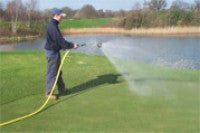
We have now been able to carry out the other development work that has included the drainage of tees and the surrounding walkway areas and the addition of further irrigation to semi-rough areas.
A large part of our improvements has been the beautification of the golf course through the enhancement of landscaped areas. Although the future time of maintaining these areas will be high the club believes that the  projects are worthwhile in our continuing quest of providing a course for our members that is second to none.
projects are worthwhile in our continuing quest of providing a course for our members that is second to none.
With the weather conditions being so good, we have been able to take advantage of the early growing conditions. Our fertiliser applications have been made to most of the turf areas already. There has been a good response already from these areas. The semi rough areas have had a granular feed of 7:7:7. The greens and tees have had a light application of Potassium Nitrate combined with a liquid feed of Nitrogen, Potassium, Iron and Calcium. Our fertiliser regime will now continue for the rest of the season throughout most of the course, the emphasis being based on liquid fertiliser applications as we have mixing tanks on the premises and are able to make our own feed at the required rates.
The main reason for hollow coring the new greens was to enable us to adjust levels and bring the mowing height down, we hope to be cutting at 3mm by the time the course is re-opened. 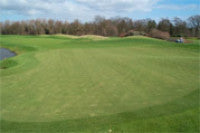
The other two courses, which have been in play through the winter, have had small amounts of repair work done caused by through traffic damage, pitch mark damage to greens and repairs to tees and fairways suffering from heavy divoting.
So although the weather has been mild for us as Greenkeepers, it has meant a higher usage of play from the members than we would normally expect in the winter.
Routine works going into the spring, taking aside the nine holes that have been redeveloped will include hollow tining going into April. I consider this as the start of the golf season and the emphasis will be on presentation of the whole course.
The staff start work at six thirty, but this will change as dawn gets earlier and our start time will be six in the morning as soon as conditions allow. We aim to have all of the courses cut by ten thirty to eleven every day, with the staff then moving on to peripheral areas and landscaping in the afternoons.
We have the luxury of taking one set of nine holes out of use every Monday during the summer season. This enables us to do disruptive maintenance such as top dressing, hollow tining, scarifying and fertilising. As far as our members are concerned all they ever see is the morning mower operations. However if the weather is bad on a Monday we still have to get the work done.
We have done very little aeration this winter. The greens and tees are of good construction and drain pretty well, the fairways tend to be wet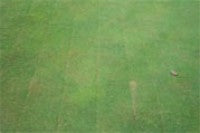 in the winter and we find that we do more damage to the areas if we try to aerate at this time of year. The major aeration works tend to be during the Spring to the Autumn, while the ground is drier. We will probably start with the 'Earthquake' on our fairways and then pursue an intensive hollow coring program of greens, tees and fairways.
in the winter and we find that we do more damage to the areas if we try to aerate at this time of year. The major aeration works tend to be during the Spring to the Autumn, while the ground is drier. We will probably start with the 'Earthquake' on our fairways and then pursue an intensive hollow coring program of greens, tees and fairways.
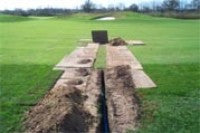 Originally in the course design and construction there was double row irrigation laid up the centre of each fairway. Membership now dictates that we have green roughs as well as green fairways. During this winter on the course that is closed we have been teeing off from these main pipes into some of the more critical rough areas. It isn't just about these areas being green, there is a good argument that a ball hitting a hard rough area can bounce away on our undulating course and become a lost ball.
Originally in the course design and construction there was double row irrigation laid up the centre of each fairway. Membership now dictates that we have green roughs as well as green fairways. During this winter on the course that is closed we have been teeing off from these main pipes into some of the more critical rough areas. It isn't just about these areas being green, there is a good argument that a ball hitting a hard rough area can bounce away on our undulating course and become a lost ball.
